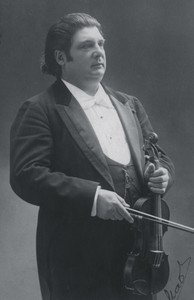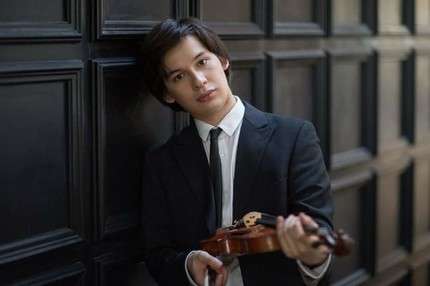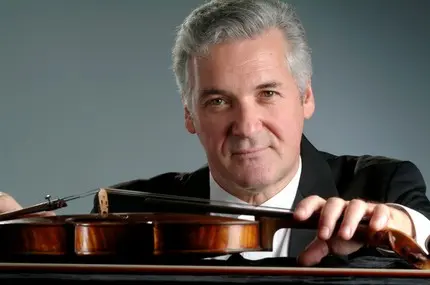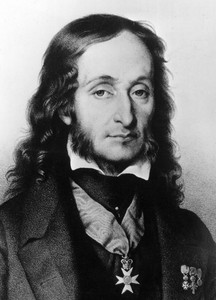
Niccolò Paganini (Niccolò Paganini) |
Niccolo Paganini
Would there be another such artist, whose life and fame would shine with such a bright sunshine, an artist whom the whole world would recognize in their enthusiastic worship as the king of all artists. F. List

In Italy, in the municipality of Genoa, the brilliant Paganini’s violin is kept, which he bequeathed to his hometown. Once a year, according to the established tradition, the most famous violinists of the world play on it. Paganini called the violin “my cannon” – this is how the musician expressed his participation in the national liberation movement in Italy, which unfolded in the first third of the XNUMXth century. The frantic, rebellious art of the violinist raised the patriotic mood of the Italians, called them to fight against social lawlessness. For sympathy with the Carbonari movement and anti-clerical statements, Paganini was nicknamed the “Genoese Jacobin” and was persecuted by the Catholic clergy. His concerts were often banned by the police, under whose supervision he was.
Paganini was born into the family of a small merchant. From the age of four, the mandolin, violin and guitar became the musician’s life companions. The teachers of the future composer were first his father, a great lover of music, and then J. Costa, a violinist of the Cathedral of San Lorenzo. Paganini’s first concert took place when he was 11 years old. Among the compositions performed, the young musician’s own variations on the theme of the French revolutionary song “Carmagnola” were also performed.
Very soon the name of Paganini became widely known. He gave concerts in Northern Italy, from 1801 to 1804 he lived in Tuscany. It is to this period that the creation of the famous caprices for solo violin belongs. In the heyday of his performing fame, Paganini changed his concert activity for several years to court service in Lucca (1805-08), after which he again and finally returned to concert performance. Gradually, the fame of Paganini went beyond Italy. Many European violinists came to measure their strength with him, but none of them could become his worthy competitor.
Paganini’s virtuosity was fantastic, its impact on the audience is incredible and inexplicable. For contemporaries, he seemed a mystery, a phenomenon. Some considered him a genius, others a charlatan; his name began to acquire various fantastic legends during his lifetime. However, this was greatly facilitated by the originality of his “demonic” appearance and the romantic episodes of his biography associated with the names of many noble women.
At the age of 46, at the height of his fame, Paganini traveled outside of Italy for the first time. His concerts in Europe caused an enthusiastic assessment of leading artists. F. Schubert and G. Heine, W. Goethe and O. Balzac, E. Delacroix and TA Hoffmann, R. Schumann, F. Chopin, G. Berlioz, G. Rossini, J. Meyerbeer and many others were under hypnotic influence violins of Paganini. Her sounds ushered in a new era in the performing arts. The Paganini phenomenon had a strong influence on the work of F. Liszt, who called the game of the Italian maestro “a supernatural miracle.”
Paganini’s European tour lasted 10 years. He returned to his homeland already seriously ill. After the death of Paganini, the papal curia for a long time did not give permission for his burial in Italy. Only many years later, the ashes of the musician were transported to Parma and buried there.
The brightest representative of romanticism in Paganini’s music was at the same time a deeply national artist. His work largely comes from the artistic traditions of Italian folk and professional musical art.
The composer’s works are still widely heard on the concert stage, continuing to captivate listeners with endless cantilena, virtuoso elements, passion, boundless imagination in revealing the instrumental possibilities of the violin. Paganini’s most frequently performed works include Campanella (The Bell), a rondo from the Second Violin Concerto, and the First Violin Concerto.
The famous “24 Capricci” for violin solo are still considered the crowning achievement of violinists. Remain in the repertoire of the performers and some variations of Paganini – on the themes of the operas “Cinderella”, “Tancred”, “Moses” by G. Rossini, on the theme of the ballet “The Wedding of Benevento” by F. Süssmeier (the composer called this work “Witches”), as well as virtuosic compositions “Carnival of Venice” and “Perpetual Motion”.
Paganini mastered not only the violin, but also the guitar. Many of his compositions, written for violin and guitar, are still included in the repertoire of performers.
Paganini’s music inspired many composers. Some of his works have been arranged for piano by Liszt, Schumann, K. Riemanovsky. The melodies of Campanella and the Twenty-fourth Caprice formed the basis for arrangements and variations by composers of various generations and schools: Liszt, Chopin, I. Brahms, S. Rachmaninov, V. Lutoslavsky. The very same romantic image of the musician is captured by G. Heine in his story “Florentine Nights”.
I. Vetlitsyna
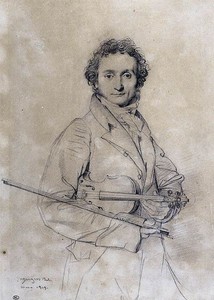
Born in the family of a small merchant, music lover. In early childhood, he learned from his father to play the mandolin, then the violin. For some time he studied with J. Costa, the first violinist of the Cathedral of San Lorenzo. At the age of 11, he gave an independent concert in Genoa (among the performed works – his own variations on the French revolutionary song “Carmagnola”). In 1797-98 he gave concerts in Northern Italy. In 1801-04 he lived in Tuscany, in 1804-05 – in Genoa. During these years, he wrote “24 Capricci” for solo violin, sonatas for violin with guitar accompaniment, string quartets (with guitar). After serving at the court in Lucca (1805-08), Paganini devoted himself entirely to concert activity. During concerts in Milan (1815), a competition took place between Paganini and the French violinist C. Lafont, who admitted he was defeated. It was an expression of the struggle that took place between the old classical school and the romantic trend (subsequently, a similar competition in the field of pianistic art took place in Paris between F. Liszt and Z. Thalberg). Paganini’s performances (since 1828) in Austria, the Czech Republic, Germany, France, England, and other countries evoked enthusiastic appraisal from leading figures in the arts (Liszt, R. Schumann, H. Heine, and others) and established for him the glory of an unsurpassed virtuoso. The personality of Paganini was surrounded by fantastic legends, which was facilitated by the originality of his “demonic” appearance and romantic episodes of his biography. The Catholic clergy persecuted Paganini for anti-clerical statements and sympathy for the Carbonari movement. After the death of Paganini, the papal curia did not give permission for his burial in Italy. Only many years later, the ashes of Paganini were transported to Parma. The image of Paganini was captured by G. Heine in the story Florentine Nights (1836).
The progressive innovative work of Paganini is one of the brightest manifestations of musical romanticism, which became widespread in Italian art (including in the patriotic operas of G. Rossini and V. Bellini) under the influence of the national liberation movement of the 10-30s. 19th century The art of Paganini was in many ways related to the work of the French romantics: the composer G. Berlioz (whom Paganini was the first to highly appreciate and actively supported), the painter E. Delacroix, the poet V. Hugo. Paganini captivated the audience with the pathos of his performance, the brightness of his images, flights of fancy, dramatic contrasts, and the extraordinary virtuoso scope of his playing. In his art, the so-called. free fantasy manifested features of the Italian folk improvisational style. Paganini was the first violinist to perform concert programs by heart. Boldly introducing new playing techniques, enriching the coloristic possibilities of the instrument, Paganini expanded the sphere of influence of violin art, laid the foundations of modern violin playing technique. He widely used the entire range of the instrument, used finger stretching, jumps, a variety of double note techniques, harmonics, pizzicato, percussive strokes, playing on one string. Some of Paganini’s works are so difficult that after his death they were considered unplayable for a long time (Y. Kubelik was the first to play them).
Paganini is an outstanding composer. His compositions are distinguished by the plasticity and melodiousness of melodies, the courage of modulations. In his creative heritage stand out “24 capricci” for solo violin op. 1 (in some of them, for example, in the 21st capriccio, new principles of melodic development are applied, anticipating the techniques of Liszt and R. Wagner), 1st and 2nd concertos for violin and orchestra (D-dur, 1811; h -moll, 1826; the final part of the latter is the famous “Campanella”). Variations on opera, ballet and folk themes, chamber-instrumental works, etc., played an important role in Paganini’s work. An outstanding virtuoso on the guitar, Paganini also wrote about 200 pieces for this instrument.
In his compositional work, Paganini acts as a deeply national artist, relying on the folk traditions of Italian musical art. The works he created, marked by independence of style, boldness of texture, and innovation, served as the starting point for the entire subsequent development of violin art. Associated with the names of Liszt, F. Chopin, Schumann and Berlioz, the revolution in piano performance and the art of instrumentation, which began in the 30s. 19th century, was largely caused by the influence of Paganini’s art. It also affected the formation of a new melodic language, characteristic of romantic music. The influence of Paganini is indirectly traced into the 20th century. (1st concerto for violin and orchestra by Prokofiev; such violin works as “Myths” by Szymanowski, concert fantasy “Gypsy” by Ravel). Some of Paganini’s violin works have been arranged for piano by Liszt, Schumann, I. Brahms, S. V. Rachmaninov.
Since 1954, the Paganini International Violin Competition has been held annually in Genoa.
I. M. Yampolsky
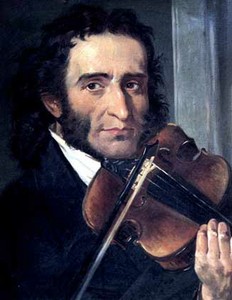
In those years when Rossini and Bellini riveted the attention of the musical community, Italy put forward the brilliant virtuoso violinist and composer Niccolò Paganini. His art had a noticeable impact on the musical culture of the XNUMXth century.
To the same extent as opera composers, Paganini grew up on national soil. Italy, the birthplace of opera, was at the same time the center of ancient bowed instrumental culture. Back in the XNUMXth century, a brilliant violin school arose there, represented by the names of Legrenzi, Marini, Veracini, Vivaldi, Corelli, Tartini. Developing in close proximity to the art of opera, Italian violin music took on its democratic orientation.
The melodiousness of the song, the characteristic circle of lyrical intonations, the brilliant “concertness”, the plastic symmetry of the form – all this took shape under the undoubted influence of the opera.
These instrumental traditions were alive at the end of the XNUMXth century. Paganini, who eclipsed his predecessors and contemporaries, shone in a magnificent constellation of such outstanding virtuoso violinists as Viotti, Rode and others.
The exceptional importance of Paganini is connected not only with the fact that he was obviously the greatest violin virtuoso in the history of music. Paganini is great, first of all, as the creator of a new, romantic performing style. Like Rossini and Bellini, his art served as an expression of effective romanticism that arose in Italy under the influence of popular liberation ideas. The phenomenal technique of Paganini, having stepped over all the norms of violin performance, met the new artistic requirements. His enormous temperament, underlined expression, astounding richness of emotional nuances gave rise to new techniques, unprecedented timbre-colorful effects.
The romantic nature of Paganini’s numerous works for violin (there are 80 of them, of which 20 have not been published) is primarily due to the special warehouse of virtuoso performance. In the creative heritage of Paganini there are works that attract attention with bold modulations and originality of melodic development, reminiscent of the music of Liszt and Wagner (for example, the Twenty-first Capriccio). But still, the main thing in Paganini’s violin works is virtuosity, which infinitely pushed the boundaries of the expressiveness of the instrumental art of his time. The published works of Paganini do not give a complete picture of their real sound, since the most important element of their author’s performing style was free fantasy in the manner of Italian folk improvisations. Paganini borrowed most of his effects from folk performers. It is characteristic that representatives of a strictly academic school (for example, Spurs) saw in his game the features of “buffoonery”. It is equally significant that, as a virtuoso, Paganini showed genius only when performing his own works.
The unusual personality of Paganini, his whole image of a “free artist” ideally corresponded to the ideas of the era about a romantic artist. His frank disregard for the conventions of the world and sympathy for the social lower classes, wanderings in his youth and distant wanderings in his mature years, an unusual, “demonic” appearance and, finally, an incomprehensible performing genius gave rise to legends about him. The Catholic clergy persecuted Paganini for his anti-clerical statements and for his sympathy with the Carbonari. It came to anecdotal accusations of his “devil loyalty”.
Heine’s poetic imagination, in describing the magical impression of Paganini’s playing, paints a picture of the supernatural origin of his talent.
Paganini was born in Genoa on October 27, 1782. He was taught to play the violin by his father. At the age of nine, Paganini made his first public appearance, performing his own variations on the theme of the French revolutionary song Carmagnola. At the age of thirteen he made his first concert tour of Lombardy. After this, Paganini focused his attention on combining violin works in a new style. Prior to that, he studied composition for only six months, composing twenty-four fugues during this time. Between 1801 and 1804, Paganini became interested in composing for the guitar (he created about 200 pieces for this instrument). With the exception of this three-year period, when he did not appear on the stage at all, Paganini, until the age of forty-five, gave concerts widely and with great success in Italy. The scale of his performances can be judged by the fact that in one season in 1813 he gave about forty concerts in Milan.
His first tour outside the homeland took place only in 1828 (Vienna, Warsaw, Dresden, Leipzig, Berlin, Paris, London and other cities). This tour brought him worldwide fame. Paganini made an amazing impression both on the public and on the leading artists. In Vienna – Schubert, in Warsaw – Chopin, in Leipzig – Schumann, in Paris – Liszt and Berlioz were captivated by his talent. In 1831, like many artists, Paganini settled in Paris, attracted by the turbulent social and artistic life of this international capital. He lived there for three years and returned to Italy. Illness forced Paganini to significantly reduce the number of performances. He died May 27, 1840.
The influence of Paganini is most noticeable in the field of violin music, in which he made a real revolution. Especially significant was his impact on the Belgian and French school of violinists.
However, even outside this area, Paganini’s art left a lasting mark. Schumann, Liszt, Brahms arranged for piano Paganini’s etudes from his most significant work – “24 capriccios for solo violin” op. 1, which is, as it were, an encyclopedia of his new performing techniques.
(Many of the techniques developed by Paganini are a bold development of the technical principles found in Paganini’s predecessors and in folk practice. These include the following: an unprecedented degree of use of harmonic sounds, which led both to a huge expansion of the range of the violin and to a significant enrichment of its timbre; borrowed from the violinist of the XNUMXth century Bieber different systems for tuning the violin to achieve particularly subtle colorful effects; using the sound of pizzicato and bow playing at the same time: playing not only double, but also triple notes; chromatic glissandos with one finger, a wide variety of bow techniques, including staccato ; performance on one string; increasing the range of the fourth string to three octaves and others.)
Chopin’s piano etudes were also created under the influence of Paganini. And although in Chopin’s pianistic style it is difficult to see a direct connection with Paganini’s techniques, nevertheless it is to him that Chopin is indebted for his new interpretation of the etude genre. Thus, romantic pianism, which opened a new era in the history of piano performance, undoubtedly took shape under the influence of Paganini’s new virtuoso style.
V. D. Konen
Compositions:
for solo violin — 24 capricci op. 1 (1801-07; ed. Mil., 1820), introduction and variations As the heart stops (Nel cor piu non mi sento, on a theme from Paisiello’s La Belle Miller, 1820 or 1821); for violin and orchestra – 5 concertos (D-dur, op. 6, 1811 or 1817-18; h-minor, op. 7, 1826, ed. P., 1851; E-dur, without op., 1826; d-moll, without op., 1830, ed. Mil., 1954; a-moll, begun in 1830), 8 sonatas (1807-28, including Napoleon, 1807, on one string; Spring, Primavera, 1838 or 1839), Perpetual Motion (Il moto perpetuo, op. 11, after 1830), Variations (The Witch, La streghe, on a theme from Süssmayr’s Marriage of Benevento, op. 8, 1813; Prayer, Preghiera, on a theme from Rossini’s Moses , on one string, 1818 or 1819; I no longer feel sad at the hearth, Non piu mesta accanto al fuoco, on a theme from Rossini’s Cinderella, op. Rossini’s Tancred, op.12, probably 1819); for viola and orchestra – sonata for large viola (probably 1834); for violin and guitar — 6 sonatas, op. 2 (1801-06), 6 sonatas, op. 3 (1801-06), Cantabile (d-moll, ed. for skr. and fp., W., 1922); for guitar and violin – sonata (1804, ed. Fr. / M., 1955/56), Grand Sonata (ed. Lpz. – W., 1922); chamber instrumental ensembles — Concert trio for viola, vlc. and guitars (Spanish 1833, ed. 1955-56), 3 quartets, op. 4 (1802-05, ed. Mil., 1820), 3 quartets, op. 5 (1802-05, ed. Mil., 1820) and 15 quartets (1818-20; ed. quartet No. 7, Fr./M., 1955/56) for violin, viola, guitar and vocals, 3 quartets for 2 skr., viola and vlc. (1800s, ed. quartet E-dur, Lpz., 1840s); vocal-instrumental, vocal compositions, etc.
References:
Yampolsky I., Paganini – guitarist, “SM”, 1960, No 9; his own, Niccolò Paganini. Life and creativity, M., 1961, 1968 (notography and chronograph); his own, Capricci N. Paganini, M., 1962 (B-ka listener of concerts); Palmin A.G., Niccolo Paganini. 1782-1840. Brief biographical sketch. Book for youth, L., 1961.



